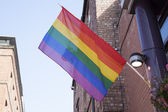The Castro in San Francisco. Boystown/Lakeview in Chicago. Greenwich Village in New York City. These neighborhoods have been known as “gay ghettos” for decades. They were the original places where LGBT people could come together and live in an area without fearing for their property or their lives. Today, many young gays and lesbians have heard of these neighborhoods as the original gay villages, and many want to visit or even move to these areas. But those who start seeking real estate in one of these popular gay neighborhoods may be in for some sticker shock.
 In many cities, these neighborhoods, which sprung up during the 60s and 70s, used to be fairly rough and run down. Real estate was fairly cheap because the homes were in need of a little care. The neighborhoods were often home to people who the rest of society considered dangerous or even criminal. Seedy bars were about the only businesses in these areas.
In many cities, these neighborhoods, which sprung up during the 60s and 70s, used to be fairly rough and run down. Real estate was fairly cheap because the homes were in need of a little care. The neighborhoods were often home to people who the rest of society considered dangerous or even criminal. Seedy bars were about the only businesses in these areas.
The major reason that these neighborhoods are becoming so expensive is gentrification, the shift of businesses and residents who make more money and tend to invest more into their communities. The more traditional and well-known LGBT neighborhoods started to attract the attention of wealthier people. They started buying up properties in these areas and renovating them, slowly transforming what were some of the poorer parts of their respective cities into very nice neighborhoods. LGBT entrepreneurs brought new businesses to the neighborhoods, and today, some of the most well-known areas like the Castro have become very wealthy communities that many middle class gays and lesbians simply can’t afford.
Unfortunately, this gentrification has caused some of the same issues that LGBT people originally moved into gay neighborhoods to escape. Gays and lesbians were pushed out of some neighborhoods because of their sexuality. This is what led to a number of gay neighborhoods being founded. Today, the high cost of living in some of these areas is doing the same thing. Those who aren’t affluent, white professionals are often unable to move into gay neighborhoods. Rent and real estate prices have risen to the point that the lower class and lower middle class can’t afford to live in the neighborhoods. Many who don’t meet a certain standard have also been pushed out of these areas.
Fortunately, while the big names like Castro and Boystown may not be affordable, there are many new gay and lesbian communities that have popped up around the world. These newer areas often are much more affordable.
